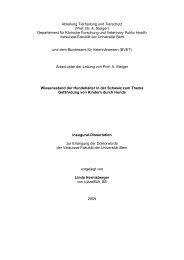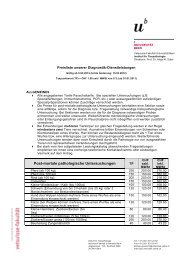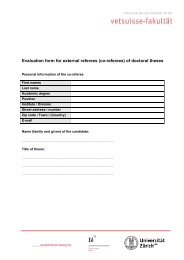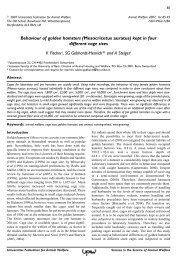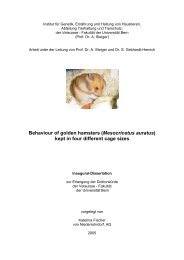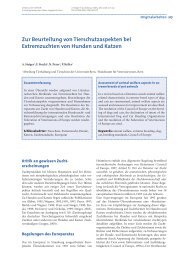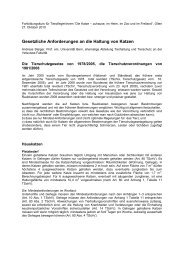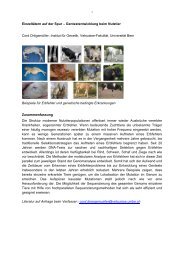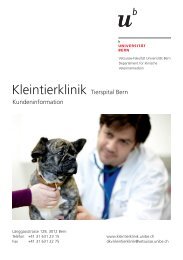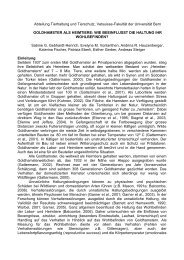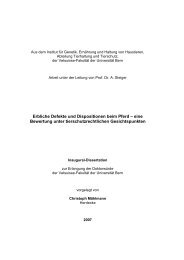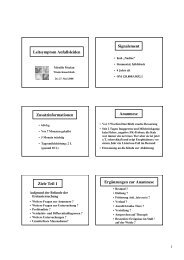Lifespan and Causes of Death in the Irish Wolfhound - Vetsuisse ...
Lifespan and Causes of Death in the Irish Wolfhound - Vetsuisse ...
Lifespan and Causes of Death in the Irish Wolfhound - Vetsuisse ...
Create successful ePaper yourself
Turn your PDF publications into a flip-book with our unique Google optimized e-Paper software.
previous results (Comfort 1960). No <strong>in</strong>formation as to <strong>the</strong>ir whelp<strong>in</strong>g dates or causes<br />
<strong>of</strong> death was provided.<br />
The Comfort studies are certa<strong>in</strong>ly a very valuable ‘glimpse <strong>of</strong> <strong>the</strong> past’. However, it<br />
must also be noted that <strong>the</strong>ir focus on one family <strong>of</strong> dogs from one s<strong>in</strong>gle kennel is<br />
somewhat problematic if we want to extrapolate Comfort’s f<strong>in</strong>d<strong>in</strong>gs on <strong>the</strong> whole<br />
<strong>Wolfhound</strong> population <strong>of</strong> <strong>the</strong> time. Unfortunately, <strong>the</strong> degree <strong>of</strong> a possible Cohort<br />
Bias (if any) cannot be deduced from his published data ei<strong>the</strong>r.<br />
3.1.2.2 Deeb <strong>and</strong> Wolf<br />
Deeb <strong>and</strong> Wolf (1994) evaluated data from <strong>the</strong> Veter<strong>in</strong>ary Medical Database <strong>of</strong><br />
Purdue University (www.vmdb.org) <strong>of</strong> dogs that had died between Jan. 1, 1982 <strong>and</strong><br />
Sept. 30, 1992. This <strong>in</strong>cluded n=116 <strong>Irish</strong> <strong>Wolfhound</strong>s. 30 % <strong>of</strong> <strong>the</strong>se died before age<br />
4, 40 % between ages 4 <strong>and</strong> 7, 25% between ages 7 <strong>and</strong> 10, <strong>and</strong> 5% lived to over 10<br />
years <strong>of</strong> age (Deeb <strong>and</strong> Wolf 1994).<br />
The period <strong>of</strong> death data collection <strong>and</strong> its group<strong>in</strong>g by year <strong>of</strong> death makes it clear<br />
that <strong>the</strong>se results are ta<strong>in</strong>ted with Cohort Bias.<br />
3.1.2.3 Li, Deeb et al.<br />
Li, Deeb et al. (1996) published an article on <strong>in</strong> vitro proliferative capacity <strong>of</strong> dermal<br />
fibroblasts as a function <strong>of</strong> body size <strong>in</strong> dogs <strong>and</strong> showed that while <strong>the</strong>re were no<br />
gender differences, <strong>Wolfhound</strong> (<strong>and</strong> Great Dane) fibroblasts had a significantly lower<br />
proliferative capacity than fibroblasts taken from dogs <strong>of</strong> o<strong>the</strong>r breeds <strong>in</strong> <strong>the</strong> same<br />
age class. However, no such correlation was found <strong>in</strong> o<strong>the</strong>r large (but not giant)<br />
breeds.<br />
The paper <strong>in</strong>cluded a lifespan evaluation <strong>of</strong> n=236 <strong>Wolfhound</strong>s provided by <strong>the</strong><br />
Veter<strong>in</strong>ary Medical Database <strong>of</strong> Purdue University (www.vmdb.org), which found that<br />
62% died between 4 to 7 years <strong>of</strong> age, 32% died between 7 <strong>and</strong> 10 years, <strong>and</strong> 6%<br />
died between 10 <strong>and</strong> 15 years. No reference as to causes <strong>of</strong> death <strong>and</strong>/or <strong>the</strong>ir<br />
percentual importance was given (Li, Deeb et al. 1996).<br />
The death class <strong>of</strong> dogs between 10 <strong>and</strong> 15 years was arbitrarily set by <strong>the</strong> Purdue<br />
Veter<strong>in</strong>ary Medical Database <strong>and</strong> might be mislead<strong>in</strong>g <strong>in</strong> <strong>the</strong> sense that, consider<strong>in</strong>g<br />
<strong>the</strong> rest <strong>of</strong> <strong>the</strong> available data as well as <strong>the</strong> f<strong>in</strong>d<strong>in</strong>gs <strong>of</strong> <strong>the</strong> study at h<strong>and</strong>, it is highly<br />
improbable that a significant number <strong>of</strong> <strong>Wolfhound</strong>s lived past 12 years <strong>of</strong> age <strong>in</strong> this<br />
dataset. Fur<strong>the</strong>rmore, it is probable that <strong>the</strong> data used were also right censored,<br />
although <strong>the</strong> extent to which this was <strong>the</strong> case rema<strong>in</strong>s unknown due to <strong>the</strong> fact that<br />
no <strong>in</strong>formation on death years is given. Similarly, <strong>the</strong> lack <strong>of</strong> a death group before<br />
age 4 implies <strong>the</strong> presence <strong>of</strong> left censored data, which also reduces <strong>the</strong> significance<br />
<strong>of</strong> <strong>the</strong>se f<strong>in</strong>d<strong>in</strong>gs as far as lifespan is concerned.<br />
3.1.2.4 Michell<br />
Michell (1999) conducted a survey <strong>of</strong> British dog owners concern<strong>in</strong>g cause <strong>of</strong> <strong>and</strong><br />
age at death <strong>of</strong> <strong>the</strong> last dog <strong>the</strong>se owners had had. N<strong>in</strong>e <strong>Irish</strong> <strong>Wolfhound</strong>s were<br />
<strong>in</strong>cluded <strong>in</strong> <strong>the</strong> answers. Mean age was 6.2 years; <strong>in</strong>ter-quartile range was 4.8 years.<br />
11



